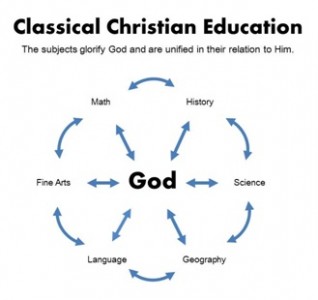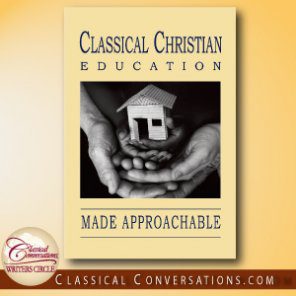What is education? Properly speaking, there is no such thing as education.
Education is simply the soul of a society as it passes from one generation to another.
– G.K. Chesterton
So my question is, “What soul are we passing from our generation to the next?” [This question involves much more than just what curriculum we are going to use to teach letters and numbers to a child.]
As with all of the books published by Leigh Bortins and Classical Conversations, I have read this book more than once because it is worth reading… and rereading.
Using a metaphorical example of building a house, Classical Christian Education Made Approachable offers a great overview of what classical Christian education is and how to implement it. At only sixty pages (with pictures, illustrations, and tables!), it is especially helpful for busy moms who need a very brief book to read which will help them easily understand the what, why, and how of classical Christian education (the when and where are thrown in there, too). Although I will present a short overview of each section of the book along with some quotes and my thoughts, I really have more than this to say about it. However, I would prefer you read the book because you will enjoy it a whole lot more than reading my comments!

The Why: After presenting a survey of the various “blueprints” of education, Classical Christian Education Made Approachable goes into the details of what makes a classical, Christian education different from other “blueprints” (such as a modern education or a non-classical Christian education) and why we would want to pursue a classical Christian education, specifically.
“When we seek improvements in education, we instinctively gravitate towards the ‘latest’ and ‘greatest’ instead of evaluating quality content. This penchant for change is profoundly present in our contemporary schools when they switch textbooks and alter teaching methodologies each year. It creeps into our homeschooling each time we change curriculum” (page 13).
Well… okay, I admit it. I have changed math curriculum four-too-many times only to discover that simpler is better. Hopefully, you will just take their word for it and not create a big experiment out of choosing curriculum. My idea was that if something was not working at the one-lesson-per-day pace, then we had the flexibility as homeschoolers to switch. It took a humbling year, last year, to realize that just because the math is written as one lesson does not mean we cannot split the lesson up over more than one day or complete more than one lesson in a single sitting! Obviously, I struggle with a Type A, stick-to-the-schedule-and-check-the-box mentality. God worked on me quite a bit last year to get me beyond this check-the-box frame of mind. (However, He is still working on me in a lot of areas.)
The How [and When]: In less than ten pages, it discusses the grammar, dialectic and rhetoric stages of the trivium:
- At the grammar stage (~ages 4-12), we are laying the foundation by focusing on memorization and recitation skills.
- At the dialectic stage (~ages 12-14), we are adding the walls, roof, and door by focusing on skills in reasoning, analyzing, and debate.
- At the rhetorical stage (~ages 14-18), we are filling the house with precious treasures as we focus on the skills of discussion, writing, and speaking.
“Classical educators lay the foundations for the house in early childhood with stories and facts which satisfy the child’s burgeoning curiosity” (page 19).
This is why we have intentionally replaced so many of our project-type educational endeavors with reading more stories. My children enjoy reading together, it sparks their imagination, and it is such precious time we can share cuddled together. I do not want to miss out on it in lieu of making one-thousand-and-one crafts. [Notice I said, “so many of,” not “all.” The boys have made duct-tape knight costumes with Dad, and they enjoy making paper crafts and trash-to-treasure trinkets, as well as Mini-Weapons of Mass Destruction, but these activities simply fall to the back burner if we lack the time to do them.]
The What: As a short summary of some of the content from Leigh Bortins’ The Core, this chapter includes what you would focus on at each stage for each of the core subjects: Scripture, literature, writing, math, geography, history, science, Latin and fine arts. It also provides much inspiration on the importance of each subject. Here are a few examples:
Inspiration for math:
“God governs the universe through the orderly language of mathematics. We can find its precepts in everything from language structure to music theory, from carpentry to formal logic, from intricate artistic designs to amazing beauty of molecular structures. Learning this language, then, allows our children to know Him aright and to worship Him with their minds” (page 39).
Inspiration for geography:
“A child who does not know much about the world around him will have narrow horizons… When classical, Christian students memorize the definitions of geography terms, they understand the variety of God’s creation. When they learn a bit about a small country like Slovenia, they develop a heart for His people” (page 40).
Inspiration for Latin:
“Studying Latin improves mental discipline, indirectly improves English vocabulary and usage, and opens the doors to reading classical and technical literature” (page 42).
“Imagine your children automatically translating the scientific names of animals and insects, gaining a fresh perspective on democracy, and reading John 1 in Latin” (page 43).
Not only does this chapter motivate me in all subjects, it also provides short, concrete descriptions of what should be focused on at each stage for almost all of those subjects. (For more detailed descriptions, you would want to read The Core, but it has more pages and not as many pictures.)
The appendix is loaded with great resources: an explanation of the Classical Conversations program, example school schedules of what a classical Christian education looks like in others’ homes, an educational goal grid (a single-page chart with a list of goals for each stage of each subject; I am making an enlarged copy to include in my personal planner), an answer to the question, “Why Latin?” (an article by Jennifer Courtney), and Dorothy Sayers’ essay, “The Lost Tools of Learning.”
Of all the books I suggest to new Classical Conversations parents [and tutors], I recommend this one the most. Due to its short length, busy moms and dads will be much more likely to read this book rather than some other books about classical Christian education. Not only that, it is my favorite, quick, go-to reference when I need to hit my mental reset button in planning our educational goals and activities.




